Who is Imad Mughniyeh, Hezbollah's mastermind legendary strategist?
Imad Mughniyeh headed Hezbollah's military, commanding two of West Asia's most resounding victories in 2000 and 2006 and inspiring the Resistance's feared Radwan Force.
-
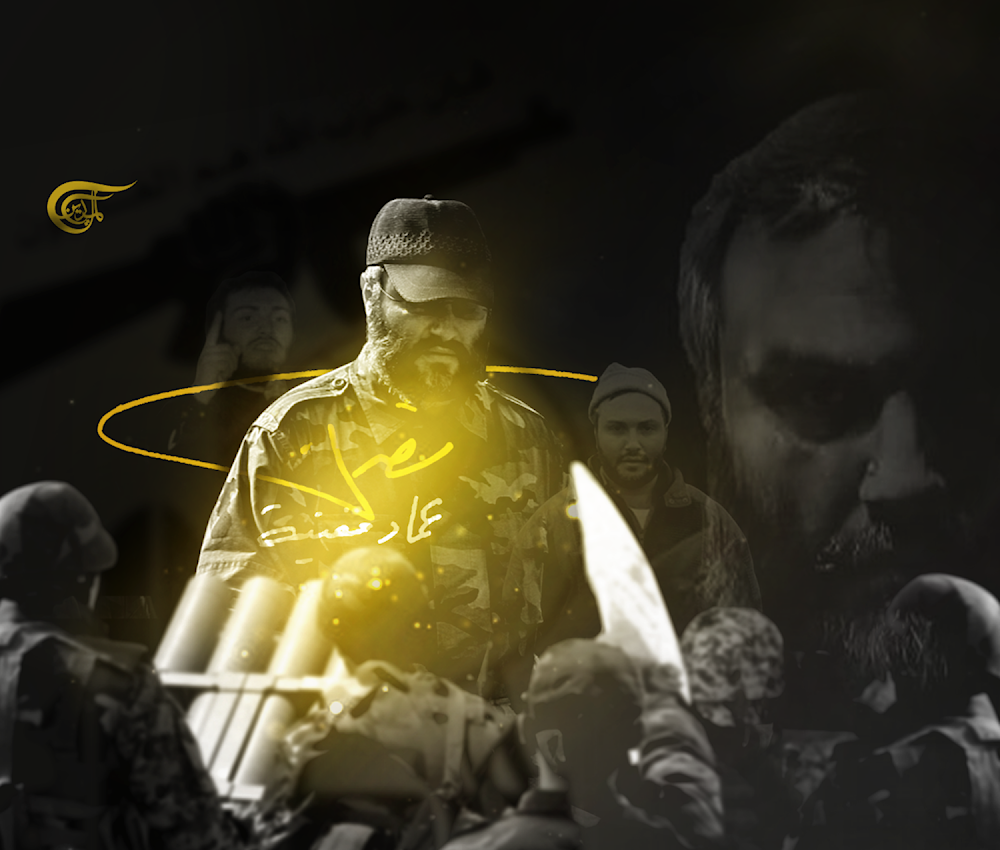
An illustration of a collection of photos released by the Islamic Resistance in Lebanon - Hezbollah of late leader martyr Imad Mughniyeh, also known as Hajj Radwan. (Al Mayadeen English; Illustrated by Hady Dbouk)
"We are today commemorating the martyrdom of a legend of our time. [We frequently use the] term 'legend', bestowing upon various individuals. However, in truth, I do not know anyone, among the general mujahideen who have sacrificed their lives or among the fighters on the resistance front, those who stand on the brink of martyrdom and await it eagerly, I do not know among them a legend like the esteemed martyr Imad Mughniyeh."
Former Commander of the IRGC's Quds Force martyr Qassem Soleimani
Sixteen years have passed since the United States and reportedly Israeli intelligence services cowardly assassinated the top Hezbollah leader and strategist martyr Imad Mughniyeh in Syria on the night of February 12, 2008.
Since then, efforts have been made to unveil the obscured facets of the martyr's personal and impeccable military life. Western media, however, have diligently endeavored to defame the "legend", depicting him as a clever "terrorist" who outwitted even the world's most sophisticated espionage organizations that were able to "find, fix, and finish" Mughniyeh after years of pursuit.
The West's convoluted criteria for evaluating terrorism have resulted in the perplexing conflation of criminals and Nazis being hailed as national heroes, while those fighting for liberation are branded as "terrorists". It appears that the sole discernible factor shaping an individual's characterization is their impact on the interests of the US-led world order. Thwarting numerous imperialist plots, Hajj Radwan earned the dubious distinction of being labeled a "terrorist" by the West. This paradox becomes even more glaring when considering the wealth of written and visual material that illuminates the career of West Asia's most prominent liberators, providing natives with the necessary background to celebrate him for his persistent and effective efforts that elevated his unwavering convictions toward realization.
Therefore, the need arises to translate and deliver to non-Arabic speaking individuals the biographies of West Asia's greatest, including Imad Mughniyeh.
Below is a detailed narration of Imad Mughniyeh's life, spanning from his formative years as a young man to the day of his martyrdom. Throughout this journey, he forged an indisputably inspirational legend, crafting a remarkable career of resistance that not only defined his era but also laid the crucial groundwork for those who would follow in his footsteps. Mughniyeh's enduring legacy and organizational accolades serve as a beacon to the region's hopes of national liberation, namely Hezbollah's elite Radwan Force, bearing his codename in homage to his great career.
Imad Mughniyeh: A Biography
Table of Contents
- Origins (1962-1980)
- Mughniyeh's political upbringing (1981-1982)
- Resisting invading, occupying forces (1982-1985)
- Mughniyeh & comrades propel Hezbollah to the forefront (1985-1995)
- The Dawn of Victory (1996-1999)
- Liberation of South Lebanon (2000-2006)
- July 12 - August 14, 2006
- Mughniyeh's assassination & the Radwan Force (2008)
Origins (1962-1980)
Imad Mughniyeh was born in Chiyah, the Southern Suburb of Beirut, in 1962, an area neglected by central Lebanese authorities that largely housed working-class Lebanese, as well as Palestinian refugees.
His parents Amina Salameh and Fayez Mughniyeh had two other sons Jihad and Fouad, both of whom were martyred in 1985 and 1994 respectively. Pointing to this fact in particular, the Secretary-General of Hezbollah, Sayyed Hassan Nasrallah, honored Mughniyeh's parents for the great sacrifices they offered for the cause of liberation.
Originally from Tayr Debba, a small Lebanese village in the Sour district, the family, like thousands of others, moved to Beirut's Suburbs, driven by Lebanon's uneven development, which gave rise to multiple political movements. These movements, aimed to deconstruct systematic economic and representative "oppression", pairing revolutionary values with the need to resist Israeli occupation forces.
Mughniyeh's political upbringing (1981-1982)
The Palestinian National Liberation Movement - Fatah, headquartered in Beirut, Lebanon, saw the conscription of a substantial number of Lebanese youth, who fought under its ranks against the Israeli occupation and its allies in Lebanon. Mughniyeh is said to have spent a good portion of his youth among the ranks of one of Fatah's elite units, although he was never a member of Fatah, where he gained essential training and began to develop his military know-how.
The success of the Islamic Revolution in Iran in 1979, under the leadership of the late Iranian leader Sayyed Ruhollah Khomeini, further ignited Mughniyeh's revolutionary spirit who had pursued religious studies in Qom. Mughniyeh also headed the security team of the late and renowned Lebanese cleric Sayyed Mohammad Hussein Fadlallah.
The late leader met Ayatollah Khomeini twice during his lifetime, the first of which he accompanied Sayyed Fadlallah to the "Conference of the Oppressed." In the second meeting, in 1981, Mughniyeh, still relatively young, only 19-20 years of age, talked to Sayyed Khomeini for around 30 minutes during which he made decisive decisions that formulated his religious and political convictions.
It is worth noting that these events were taking place in parallel to drastic geopolitical and local changes that led up to the next critical phase of the martyr's life.
Resisting invading, occupying forces (1982-1985)
Israeli invasion
On June 6, 1982, Israeli occupation forces, under the direction of then-Security Minister and renowned war criminal Ariel Sharon, launched an invasion into southern Lebanon that reached the Lebanese capital of Beirut, with the aim of "squashing" Palestinian and Lebanese Resistance factions.
Mughniyeh, who was visiting Tehran, cut his stay and traveled back to Lebanon, assisting his comrades on several fronts in Khaldeh, Beirut, and the Southern Suburb of Beirut.
As a result, Mughniyeh suffered injuries to his leg during confrontations in the town of Ghobeireh in the Southern Suburb of Beirut. With the eventual withdrawal of the Fatah-led Palestinian Liberation Organization (PLO) from Beirut, Mughniyeh worked to utilize a substantial amount of weapons and ammunition left behind by the PLO, transferring the equipment to Resistance cells in South Lebanon.
Following the Israeli invasion, a group named the Islamic Jihad Organization began to conduct operations against Israeli and foreign forces in the country. Reportedly, Mughniyeh and others were part of the faction that claimed responsibility for multiple attacks. During this buffer period, from 1981 to 1985, the Islamic Resistance in Lebanon - Hezbollah began to crystalize to eventually launch its manifesto on the crucial day of the one-year anniversary of Sheikh Ragheb Harb's assassination on February 16, 1985, with Hajj Radwan being one of its founders.
-
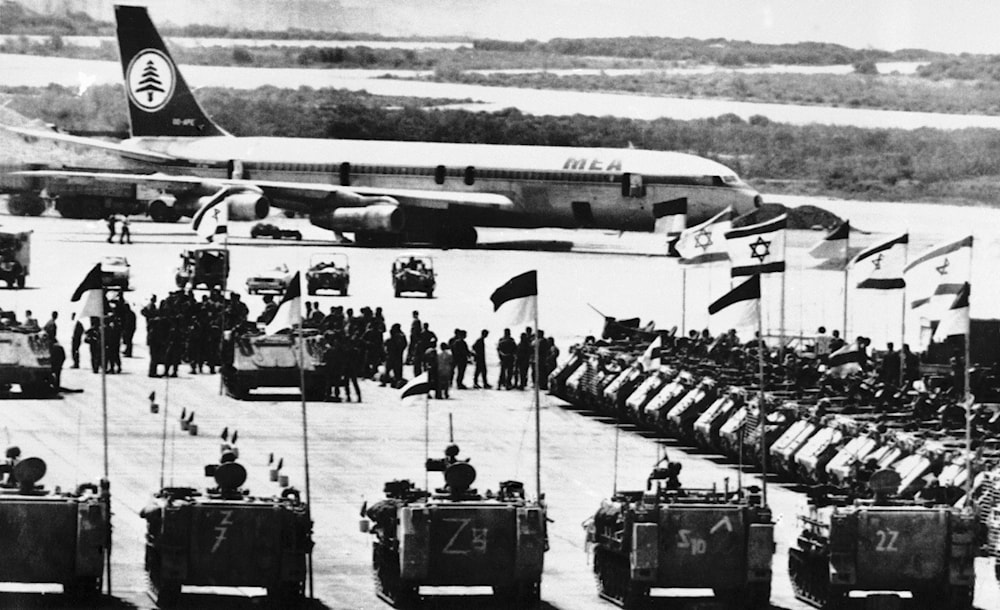
Israeli occupation forces conduct a ceremony at the Beirut airport in Lebanon, in September 1982. (AP)
Annihilating enemy HQs
Thinking outside of the box, the young Resistance fighter did not busy himself with direct confrontations with Israeli forces that occupied the second Arab capital, Beirut. Instead, the future leader began to plan tightly knit ambushes, focusing on inflicted damage on Israeli assets and troops behind enemy lines. Mughniyeh's ambushes included sniper ambushes and the shelling of groupings of Israeli soldiers in South Lebanon. The first substantial operation that Mughniyeh commanded occurred on October 11, 1982, when a huge explosion went off in the headquarters of the Israeli occupation's military governor in Sour.
11/11 will be remembered as the day that initiated the era of martyrdom operations, in which martyr Ahmad Kassir drove a Mercedes laden with 200 kg of explosives into the headquarters, detonating it upon arrival, killing 76 Israeli officers and soldiers in one go. Hezbollah would announce its responsibility for the attack and the name of the operation's executor in 1985.
About a year after the martyrdom operation of Ahmad Qassir, another martyr attacked the Israeli intelligence headquarters in Sour. Israeli forces failed to stop the martyr, who turned the building into rubble, killing at least 29 Israeli troops. No one claimed responsibility for the attack, and the attacker's name was never revealed.
US-led multinational force
In October 1983, then-US President Ronald Reagan's administration accused Hajj Radwan of planning a bombing on the US embassy in Beirut, the headquarters and barracks of French paratroopers, and the US Marine Corps. The Federal Bureau of Investigation (FBI) offered a $25 million reward for his capture. Although no evidence of his or Hezbollah's involvement was produced, Muyghniyeh rose to international prominence and his name became synonymous with the attacks that killed 241 US troops and 58 French paratroopers.
The FBI Forensic Laboratory's personnel investigating the scene of the attack on the barracks compound said it was the largest non-nuclear blast that they have witnessed. Explosives equivalent to six tons of TNT destroyed the sites in a simultaneous attack conducted by two explosive-laden trucks. The attack marked the largest toll of killed US troops since World War II.
The operations came against the backdrop of a "multinational military coalition," which included the United States, the United Kingdom, France, and Italy, established in 1981. However, remarkable acts of Resistance brought the MNF's plots to a quick end, marked by a series of unilateral withdrawals that concluded in March 1984.
-
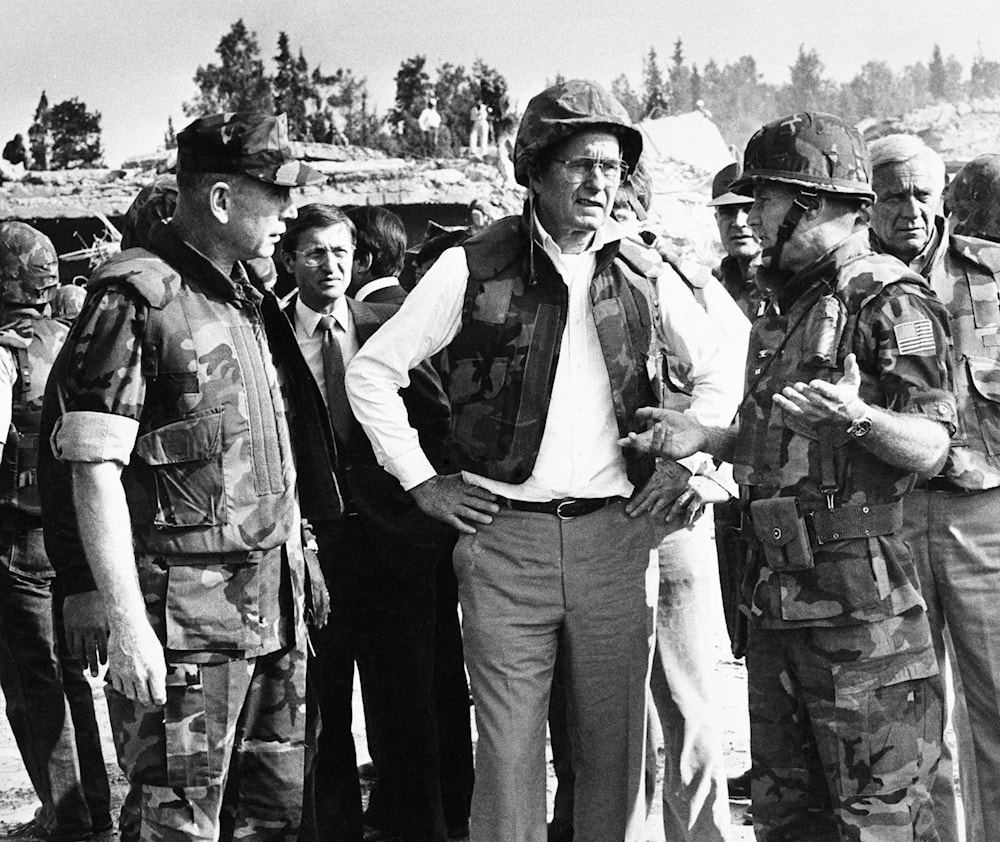
Then-US Vice President George Bush, center, wearing a flak jacket and steel helmet, is briefed at the site of a truck bomb attack on the US Marine barracks, near Beirut airport, Lebanon. At left is Marine Corps Commandant Gen. Paul Kelly and right is Col. Timothy Geraghty, on October 26, 1983. (AP)
Mughniyeh & comrades propel Hezbollah to the forefront (1985-1995)
Hajj Radwan played an intrinsic role in forming and propelling the Islamic Resistance in Lebanon -Hezbollah, however, details about the martyr's personal life remained obscure. His role in the party remained hidden, forming his identity, eloquently described by Sayyed Hassan Nasrallah, as the "man of the shadow."
Forming the first security cell (1985)
An allegedly CIA and British intelligence-sponsored car bombing on the seven-story residential building and a cinema in Bir al-Abed, in the Southern Suburb of Beirut, on March 8, 1985, targeting Sayyed Fadlallah, whom Mughniyeh and his brother had close ties to, further motivated the Hezbollah leader. The bombing led to the martyrdom of 80 people and injury of 256, but Sayyed Fadlallah survived the assassination attempt. Those who planned the attack timed the bomb to go off as the worshippers left Friday Prayers, pointing to the maliciousness of the attackers.
-
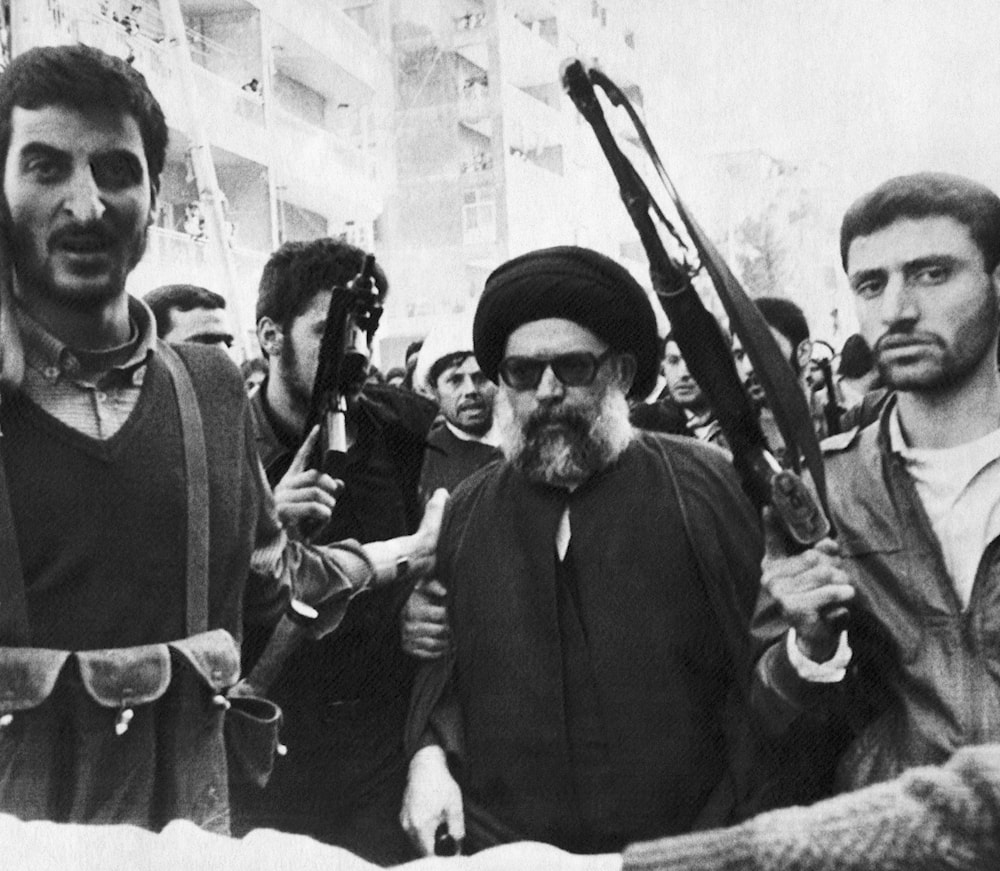
Sayyed Mohammad Hussein Fadlallah, surrounded by his bodyguards, walks up to a mosque in the Southern Suburb of Beirut, Lebanon, for the funeral ceremony of the 80 victims of a car bombing attack blamed on the CIA whose target was Sayyed Fadlallah, on March 9, 1985. (AP)
According to Qaf Center, an organization devout to the "culture of Resistance," which was established against the backdrop of Mughniyeh's assassination, the Resistance leader and his comrades, "successfully targeted the entire network of agents associated with the bombing."
Mughniyeh's work established Hezbollah's first security cell, responsible for taking out high-profile figures among enemy lines, including Israeli personnel and high-ranking collaborators.
The security war between Hajj Radwan and the Israelis, later known as the "Brains War", would continue, marked by the operation of the martyr Abdullah Atwi in Mleeta and the bombing of the Israeli intelligence headquarters in Saida, Qaf's explanatory cards read.
The first Intifada (1987)
In parallel to the resounding first Intifada occurring in occupied Palestine, Islamic Resistance fighters under Mughniyeh's command escalated their operation in confrontation with Israeli occupation forces in Lebanon. The leader conducted and commanded several defining top-tier operations against occupation soldiers.
Assassination of Sayyed al-Musawi, Buenos Aires (1992)
On February 16, 1992, the Israeli occupation assassinated Hezbollah's leading figure and Secretary-General, Sayyed Abbas al-Musawi. The escalation was marked by another from the opposing side, which introduced the short-range Katyusha rockets. At the time, Imad Mughniyeh had been tasked with the role of leading the Resistance's security apparatus.
Mughniyeh was directly accused of the bombings in Buenos Aires, Argentina, thousands of kilometers away from Lebanon. This included an operation on March 14, 1992, a few weeks after the assassination of al-Musawi, in which the Israeli embassy in Buenos Aires was bombed.
-
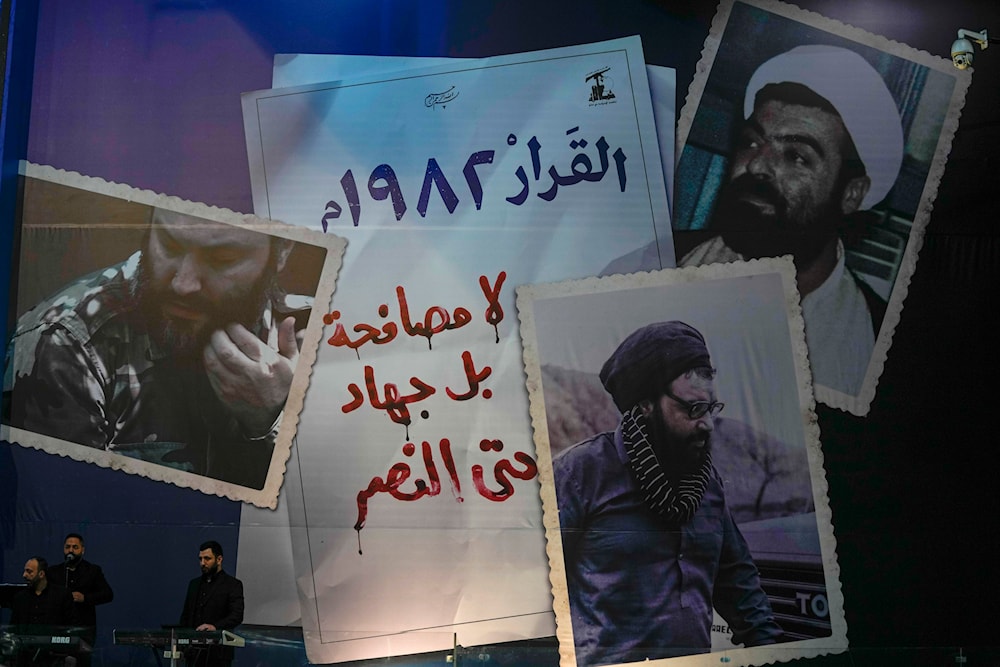
A large poster displaying a collage of photos of Hezbollah's late leaders and martyrs. Imad Mughniyeh, left, Sheik Ragheb Harb, right, and Sayyed Abbas al-Musawi, center, during an annual ceremony commemorating the lives of the three leaders on the anniversary of Sheikh Ragheb's assassination, in the Southern Suburb of Beirut, Lebanon, on February 16, 2022. (AP)
Katyusha rockets open new horizons (1993)
The Seven-Day War in July 1993, codenamed "Operation Accountability" by the Israeli forces, stands out as a critical moment, representing the widest and most intense Israeli military aggression since 1982. In the face of the enemy's onslaught, which comprised 1,124 raids in which 28,000 shells were launched at Lebanese territories, Hezbollah demonstrated remarkable resilience.
Mughniyeh, in particular, played a pivotal role in orchestrating the defense strategy, effectively edging the balance toward the defenders. Through the group's limited capabilities and against the overwhelming superiority of the Israeli war machine, Hezbollah was able to deliver stern responses to Israeli attacks. During this critical period, the leader skillfully employed multiple rocket launchers to impose a new equation. This strategic move not only showcased Hezbollah's adaptability, under Hajj Radwan's leadership but also transformed Israeli settlements in northern occupied Palestine into targets of the Resistance's rockets.
The Dawn of Victory (1996-1999)
The Dawn of Victory against the Israeli occupation began to approach in 1996 with a broad escalation, represented by the Israeli-launched aggressions, codenamed "Grapes of Wrath" against Lebanon. Attempts to liquidate the Resistance had the opposite effects, as Hezbollah not only survived the onslaught but also began to turn the tide against the Israeli occupation.
One operation after the other, the occupation began to withdraw its forces from key areas in Lebanon, marking tangible victories for the Islamic Resistance.
On September 4, 1997, Hezbollah executed an ambush targeting the Israeli occupation's elite Navy reconnaissance Shayetet Unit, in the Lebanese town of Ansariya located between the cities of Saida and Sour. A month earlier, an Israeli force had infiltrated the town of Kfour and planted a bomb, targeting a Resistance commander. The Shayetet force was expected to do the same in the coastal town of Ansariya, however, Hezbollah's ambush killed 12 Israeli troops, marking the worst single-day toll in Lebanon since 1985. The Qaf center says the operation and others held the "signature" of Mughinyeh.
Topping off this era of operations was the assassination of Israeli Brigadier General Erez Gerstein, who commanded the Israeli occupation forces Liason Unit in South Lebanon. Gerstein and two other warrant officers were killed on March 2, 1999, after an improvised explosive device laid by Hezbollah fighters was set off between Ibl al-Saqi and Kawkaba.
The operation was conducted within what "Israel" called its "security zone", to the south of the Litani River, marking yet another victory for Mughniyeh and his comrades.
Liberation of South Lebanon (2000-2006)
"Israel" sought to withdraw from Lebanon quietly as several cracks started to appear in its front, and while it expected its withdrawal from occupied southern Lebanon to be quiet and swept under the rug, that could not be further from the truth. They thought there would not be too many deaths — that they would be able to achieve a painless withdrawal — but Hajj Imad and his comrades thought differently. Their ideas became a crushing reality for the Israeli occupation.
Hajj Radwan insisted on humiliating the Zionist occupation, and after no more than 14 hours had passed on the killing of the treacherous Aql Hashem, the top collaborator with "Israel", the Resistance dealt a serious blow to their ranks, with missile strikes and incursions showering the Israelis and their "Lebanese" collaborators until they were chased out of Lebanon, fleeing the wrath of the Resistance and the swords of liberation. The Israelis were pushed back beyond the border wall drawn up and erected by the colonialist powers.
-
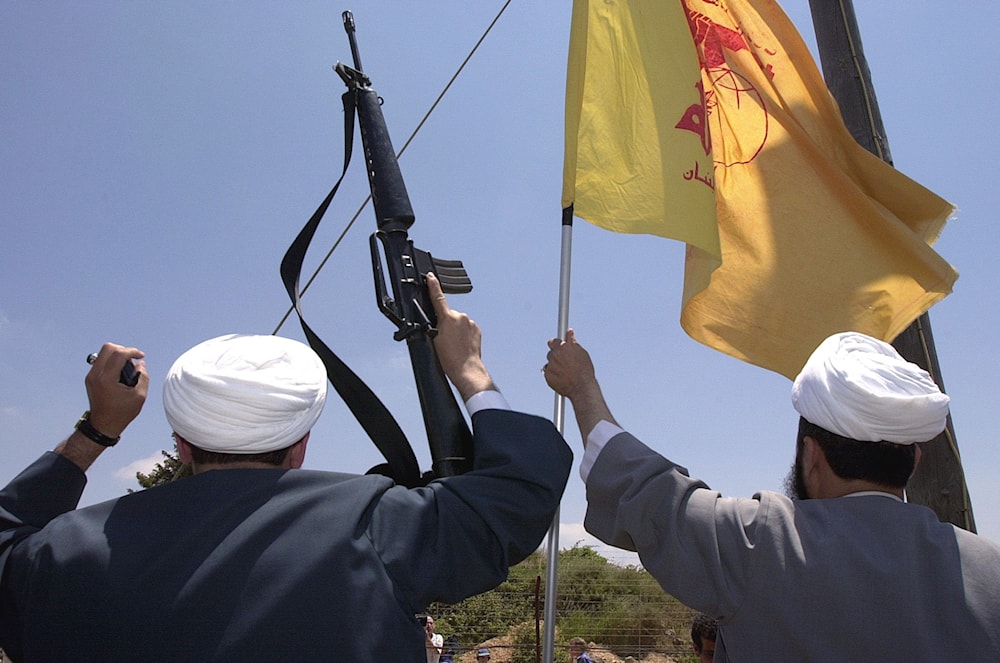
Two Muslim clerics hold up a Hezbollah flag and an M-16 assault rifle near the "separation fence" in the village of Kfar Kila, South Lebanon, after the withdrawal of Israeli troops and collaborators from the area, on May 24, 2000. (AP)
Give the enemies no break
Not one day passed from January until the Day of Liberation in May without the Resistance irking the Israelis and turning their lives into a living hell, and thus, on May 25, 2000, victory was attained by the righteous rifles of the freed fighters, whose blood demarcates until this day the Lebanese borders, and while not all of Lebanon has been liberated, the plight of the Resistance and that of the oppressed will try day and night to make liberation a reality for not only the Lebanese but the Syrians and the Palestinians as well.
Just as Sayyed Nasrallah said, when commemorating the slain Resistance commander whose life's purpose was the liberation of all Arab territories from the Western and Western-backed and -installed oppressors, the path Hajj Radwan paved for the Arab and Muslim youth will end in the victory of the righteous, and his actions will reverberate for generations and millennia to come.
"If the blood of Sheikh Ragheb [Harb] forced them off the majority of Lebanese territories, and if the blood of Sayyed Abbas [Moussawi] forced them out of the occupied border area with the exception of the Shebaa farms, the blood of Imar Mughniyeh will uproot them from existence if God wills it."
Sayyed Hassan Nasrallah, February 14, 2008
The operations carried out by the Lebanese Resistance fighters inspired the people of southern Lebanon to go back home, parading their villages once again after they had been usurped by the colonial entity for years. Resistance, in this case, had come full circle: after it was born from the wounds of the people of South Lebanon and used as a tool to confront the occupiers, it, in itself, gave impetus to the people to retake their land in an emotional and inspirational battle that ensured the liberty of not just a few kilometers of Lebanese territory, but that of an entire nation.
As Hajj Imad joined the people of South Lebanon in their return to their homes, his wish had come true, as he got to breathe in the fresh air of occupied Palestine that the Lebanese had been forbidden from for 52 years at that point, and amid his overwhelming sense of joy, he cut off a piece of the barbed wire separating Lebanon from its occupied neighbor whose liberation was within a whisker.
-
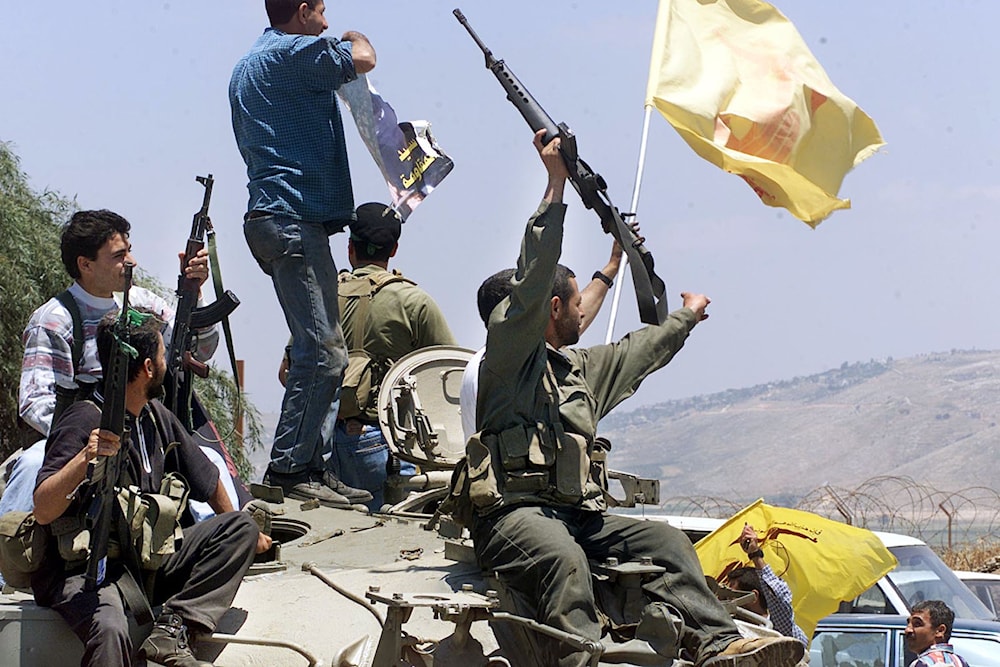
Hezbollah fighters wave their guns and flags toward occupied Palestine next to the "separation fence" in the border town of Kfar Kila, South Lebanon, on May 24, 2000. (AP)
Turning the tide
His lifelong goal and dream of liberating occupied Palestine was just right there, within reach, and none of his sacrifices, losses, and hardships mattered anymore, for he was breathing the beautifully crisp air of occupied Palestine for the first time in his life.
While the liberation of the southern Lebanese territories, with the sole exception of the Shebaa Farms, Kfar Chouba Hills, and al-Ghajar town, was achieved, this historical landmark would be nowhere near the end goal, for Hajj Imad had his eyes set beyond breathing Palestinian air through the unjustly erected border fence; he wanted to roam Palestine and breathe in the air of occupied al-Quds, and the struggle was just getting started.
Hajj Radwan's career up to this moment signified an all-out comeback of the Resistance, cementing the choice of confrontation rather than impotent political settlements. Hajj Imad and those who trod with him on the path of Resistance suffered multiple letdowns of failing Arab armies and the relocation of the PLO away from Lebanon. However, the sheer persistence and clever execution of top-tier strikes turned the tide of West Asia and put the imperialists and colonialists on the back foot.
Mughniyeh ignited the fire in enemy territory
In the early 2000s, Hajj Imad's name was reverberating across not only the Israeli occupation but the collective West as a whole, with international intelligence agencies seeking him in connection to the smuggling of rockets to the occupied Gaza Strip; little did they know, not only was he supplying the Resistance with the appropriate weapons to uproot the occupying Israeli regime, he was training Palestinian Resistance fighters in Gaza, forming the nucleus of what would become the Palestinian Islamic Jihad's al-Quds Brigades and the Popular Resistance Committees' al-Nasser Salah al-Din Brigades, according to Qaf.
A year into Lebanon's liberation, there were more leads linking the legendary Resistance leader to the Palestinian Resistance and its supply chain of armaments, from the capture of the Santorini ship on May 21 during its fourth mission to the Karine-A ship caught in the Red Sea in May 2002. In both incidents, Israeli authorities pointed their fingers at Hajj Radwan being a main supporter of the Palestinian Resistance and claimed that he was deeply connected to the Fatah Resistance Movement and its leader, Yasser Arafat.
Mughniyeh's dedication to aiding regional Resistance movements did not stop upon the Israeli withdrawal beyond the "Blue Line"; it was only given impetus, for when he experienced the slightest bit of freedom, he was not going to stop there, digging viciously to reach the end of the tunnel that would see the uprooting of the Israeli regime from occupied Palestine.
Gaza's liberation (2005)
Mughniyeh's efforts, namely the training of Palestinian youths and his coordination of the supply of armaments to the Gaza Strip, were heavily disruptive for the Israelis, who could not find a way to dry up the supply of weapons to Gaza, and led the Israeli occupation to start its first phase of withdrawal from Gaza 38 years into its occupation of the Palestinian territory. The steadfast resistance of Palestinians, supported by Mughniyeh and his comrades, forced an armed force, proclaimed as one of the top ranking regionally, to leave with its tail between its legs from a territory that is a mere 365km².
Preparing for what is to come
The great Lebanese Resistance commander, whose compass knew nothing but Palestine, worked around the clock to prepare for the upcoming war, developing unprecedented strategies that put to shame any other guerilla warfare and transforming the essence of the Islamic Resistance in Lebanon greatly by nurturing its military and spiritual sides. Most importantly, his efforts led the Resistance to have a missile arsenal like no other, efforts that were built upon for years to come and that wound up putting tens of thousands of rockets and missiles, and even ballistic missiles, in Hezbollah's possession, rendering it more of an existential threat to the Israeli occupation than it had ever been.
Concurrently, Hajj Radwan was appointed as the military assistant to Hezbollah's Secretary-General Sayyed Hassan Nasrallah. The event marked a great transformation in the movement's organizational structure, as the role of the assistant was previously upheld by three commanders rather than one.
Mughniyeh had mastered the art of war, achieving accolades in every possible sector of military and security work. According to Hezbollah's Executive Council Deputy Chief, Sheikh Nabil Qawouq, Mughniyeh started to plan for the next stage of confrontation with the Israeli enemy as soon as South Lebanon was liberated in May 2000. Sheikh Qawouq, who accompanied Mughniyeh during the period of Liberation, said that he had told him that a plan to liberate Resistance fighters imprisoned by Israeli forces had already begun to crystalize.
In this context, Sayyed Nasrallah revealed that Mughniyeh headed a top-secret mission to train dozens of Hezbollah fighters on the use of anti-tank guided missiles (ATGMs). The project remained a complete secret until the outbreak of the 2006 war, proving essential in the movement's defensive strategy.
⭕️ رماةٌ ماهرون... pic.twitter.com/sGMtmozR45
— iBra 💉 إبرة ® (@ib_reb) January 18, 2024
Moving to reconnaissance and cyberwarfare
Hajj Imad's efforts extended far beyond the notion of Resistance as an armed struggle, for his contributions on the cultural and intelligence levels were quintessential to the establishment of Hezbollah as a regional and even international force to be reckoned with. He focused on nurturing and developing human resources in the military, security, cultural, and spiritual aspects. He also developed Hezbollah's communication network and systems, allowing its communication to be covert and safe from hostile interference, and from that, he focused on reconnaissance and cyberwarfare.
Aiming to break the West's monopoly on information, especially on security-related issues, he established a specialized unit for monitoring and translating Western and Hebrew scientific security studies, research reports, and media. Mughniyeh closely followed details related to the enemy, its arsenal, and the military status quo, seeking to understand various aspects of the Israeli occupation.
Mughniyeh invested in the victory on the public and media fronts, meeting with numerous top officials and coordinating high-level meetings on the regional level while also encouraging the masses to visit the territories liberated by the Lebanese Resistance in 2000 in order to boost morale and show the people what could be achieved through resistance and armed struggle.
July 12 - August 14, 2006
On July 12, 2006, Hajj Radwan's plan to attain the release of those remaining in Israeli prisons materialized. After conducting several exercises simulating the event, Hezbollah's Resistance fighters executed Operation Truthful Promise to a tee, taking [the bodies of] two Israeli soldiers captive to make the exchange.
With news of the successful operation reaching top Israeli officials, then Israeli Prime Minister promised Lebanon a "very painful and far-reaching response." Soon after, the Israeli cabinet authorized an aggression on the country until the two Israeli soldiers taken captive were returned.
Mughniyeh commanded Hezbollah's forces, which fended off the most-ever egregious Israeli aggression on Lebanon. Hezbollah's ATGM program proved quintessential in Bint Jbeil and Maroun al-Ras, where an extremely small number of fighters pushed back against entire Israeli battalions. The sheer asymmetry between the two sides marked one of history's most shocking defeats and what was later known as Hezbollah and Lebanon's Divine Victory.
Mughniyeh, Sayyed Nasrallah, and the Quds Force commander Hajj Qassem Soleimani closely followed all the details of the military operations. Hajj Radwan's role on the ground included following up with combat and support, accompanying the progress of operations, and determining the timing of "surprises". He was also responsible for protecting the leadership of Hezbollah, and he was keen on checking on his fellow fighters.
The epic of 2006 was concluded on August 14, later leading to the achievement of the Resistance goals behind the operation.
-

Liberated prisoner Samir Kantar salutes people as he arrives to pay respect at the grave of Hezbollah military commander martyr Imad Mughniyeh, in the Southern Suburb of Beirut, Lebanon, on July 17, 2008. (AP)
Mughniyeh's assassination & the Radwan Force (2008)
While his career was shrouded in mystery and his entire biography was unknown, living his life in secret and only being known to the enemy as "Radwan", and after being chased by over 40 intelligence apparatuses over the course of 25 years, the iconic Resistance mystery figure wound up being known to the public in one of the most heart-aching ways possible; with his 2008 assassination that brought pain and sorrow to those who knew his importance to the Axis of Resistance.
Mughniyeh was assassinated in Damascus' Kfar Sousa, after holding a meeting with top officials in the Axis of Resistance. A joint Mossad-CIA plot brought the great martyr's career in the Resistance to an end. In detail, operatives of the intelligence agencies switched out one of his SUV's tires for an explosive-laden tire, engineered in the United States, which instantly killed Hajj Radwan upon detonation.
"They should hear me well: [Imad Mughniyeh] has left behind for you, tens of thousands of fighters, well-trained and prepared, ready for martyrdom."
Sayyed Hassan Nasrallah, February 14, 2008
While he is still mourned 16 years later, Mughniyeh established the groundwork for Hebzollah's military and security operations, which have been carried on by his comrades and students. Following the 2006 war on Lebanon, Mughniyeh began to plan for the next step on the path of liberation. His vision involved creating a commando force capable of penetrating deep into enemy territory. Though the force was not fully established before his tragic assassination, Hezbollah's commanders honored the Resistance leader's legacy by naming it the "Radwan Force".
Today, the Radwan Force, encompassing various units, such as armored units, fire-support units, anti-armored units, and a media unit, stands as the embodiment of Mughniyeh's strategic foresight. Its primary objective is to launch a large-scale operation in al-Jalil, occupied Palestine. Mughniyeh's codename continues to haunt Israeli officials, occupiers, and settlers, underscoring the lasting impact of his contributions to West Asia's Resistance movements.
الرضوان... pic.twitter.com/L35NJjeTbg
— جهاد غدار (@jihadghaddar) January 30, 2024

 24 Min Read
24 Min Read










